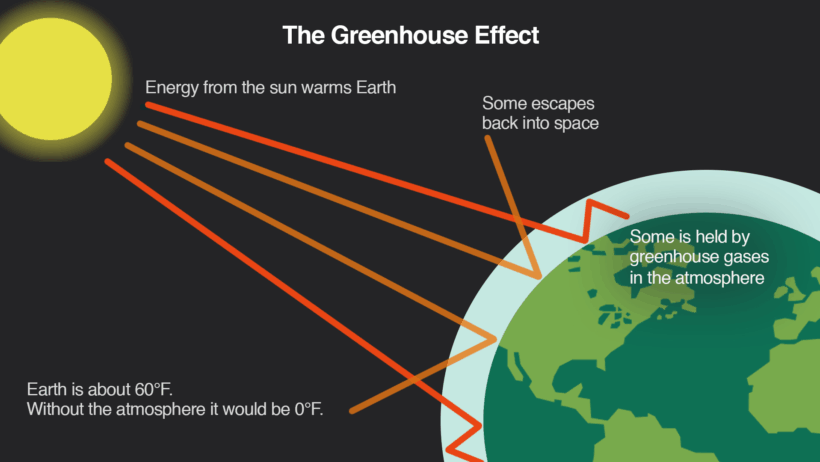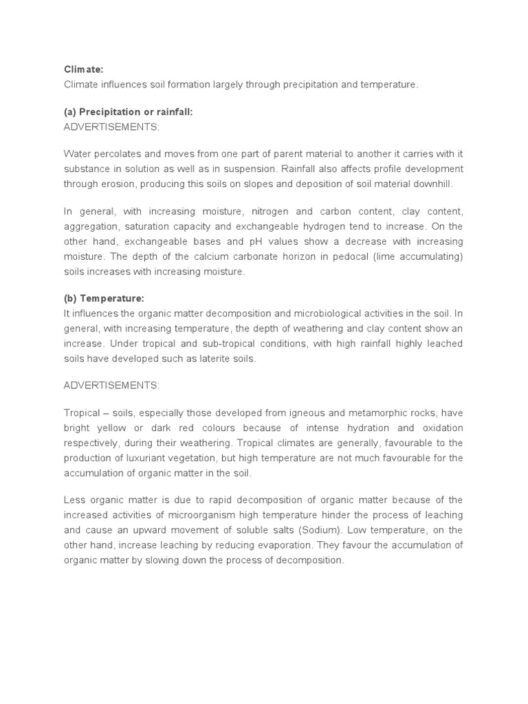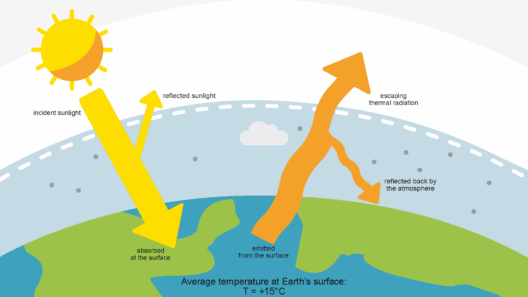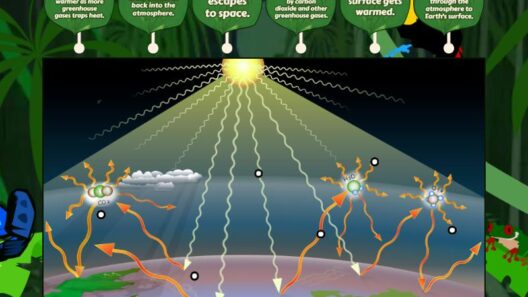In the vast expanse of Earth’s atmosphere, an intricate dance between solar radiation and terrestrial heat occurs. This phenomenon, known as the greenhouse effect, is instrumental in maintaining life as we know it. However, the dynamics of the greenhouse effect are often misunderstood, leading to misconceptions about its role in climate regulation. This article delves into the quintessential descriptions of the greenhouse effect, aiming to provide clarity and understanding.
The greenhouse effect is fundamentally a natural process. Solar energy reaches our planet, where it is either absorbed or reflected. Some of this absorbed energy warms the Earth’s surface, which then emits heat back into the atmosphere in the form of infrared radiation. Greenhouse gases, which include carbon dioxide (CO2), methane (CH4), and water vapor, play a pivotal role by absorbing and re-emitting this infrared radiation. Consequently, they act like a blanket, trapping heat within the atmosphere and ensuring that our planet remains temperate enough to sustain life. Without this effect, Earth would be a frigid wasteland, with surface temperatures averaging approximately -18 degrees Celsius, rather than the balmy 15 degrees Celsius we currently experience.
Despite the ubiquity of the term “greenhouse effect,” it is imperative to distinguish between its beneficial and adverse impacts. This complexity underpins the need for a more nuanced understanding.
Understanding the Greenhouse Effect: Examining Its Core Components
The greenhouse effect operates through a delicate balance between incoming solar radiation and the outgoing heat from Earth’s surface. To wholly comprehend this mechanism, one must delve into its principal components and interrelated processes.
First and foremost, the sun emits energy across the electromagnetic spectrum, with the majority radiating in the form of visible light. This energy travels through the vacuum of space and reaches Earth, where it is absorbed by the land, oceans, and atmosphere. The absorption of energy causes an increase in temperature, resulting in the phenomena we perceive as weather and climate.
As the Earth warms, it re-radiates energy back towards space, primarily in the form of infrared radiation. This is where greenhouse gases come into play. Unlike visible light, infrared radiation is less energetic. Greenhouse gases effectively absorb this outgoing radiation and re-radiate it in all directions, including back towards the Earth’s surface. This process enhances the warming effect, ensuring that temperatures remain conducive to life.
Key greenhouse gases include carbon dioxide, methane, nitrous oxide, and ozone. Carbon dioxide, perhaps the most infamous, is released during combustion processes, deforestation, and certain natural phenomena such as volcanic eruptions. Methane, a gas with a warming potential significantly higher than CO2, is emitted during agricultural practices and via fossil fuel extraction. The cumulative impact of these gases intensifies the greenhouse effect, contributing to rising global temperatures.
The Human Element: Anthropogenic Influences on the Greenhouse Effect
The natural greenhouse effect is paramount; however, human activities have exacerbated its consequences. The industrial revolution marked a significant escalation in greenhouse gas emissions, leading to an unprecedented acceleration in global warming. This has engendered concerns regarding climate change, as the delicate balance that once existed is now precariously disrupted.
Foremost among these anthropogenic influences is the relentless consumption of fossil fuels. The burning of oil, coal, and gas releases copious amounts of CO2, pushing atmospheric concentrations to unprecedented levels. Simultaneously, land-use changes—particularly deforestation—further diminish the planet’s ability to sequester carbon, exacerbating the issue.
In addition to fossil fuels, agricultural practices contribute substantially to greenhouse gas emissions. Livestock farming, for instance, produces methane during digestion, while the use of synthetic fertilizers generates nitrous oxide, both potent greenhouse gases. Furthermore, urbanization and industrial processes render the atmosphere increasingly saturated with heat-trapping gases, amplifying the greenhouse effect. The ramifications of these actions span ecosystems, weather patterns, and human health, underscoring the urgency of addressing climate change.
Mitigating Climate Change: The Role of Solutions and Innovations
Given the perils associated with an intensified greenhouse effect, innovative solutions and strategic mitigation efforts must be pursued. Global initiatives aimed at reducing greenhouse gas emissions hold promise for curtailing climate change impacts. The adoption of renewable energy sources, such as solar, wind, and hydroelectric power, offers a pathway toward minimizing reliance on fossil fuels.
Enhancing energy efficiency across various sectors—including transportation, industry, and building design—can yield substantial reductions in emissions. The transition to electric and hydrogen-fueled vehicles serves as one example of how technology can transform sectors to be more environmentally friendly.
Furthermore, conservation efforts, such as afforestation and reforestation, restore ecosystems and sequester carbon. Sustainable agricultural practices can mitigate methane emissions while improving soil health. By adopting circular economy principles, we can promote sustainable consumption patterns that significantly lower our carbon footprint.
The green revolution in technology and innovation is pivotal, but public commitment is equally fundamental. Educating individuals and communities about the greenhouse effect, climate change, and the ramifications of unsustainable practices fosters a culture of environmental stewardship.
In conclusion, while the greenhouse effect is essential for life on Earth, understanding its complexities—particularly in light of human influences—is imperative. By fostering comprehension and advocating for proactive measures, society can mitigate the adverse impacts of climate change and ensure a sustainable future for generations to come. The path forward is neither simple nor immediate, but through concerted global action and dedication, a resilient, thriving planet may still be within our reach.







